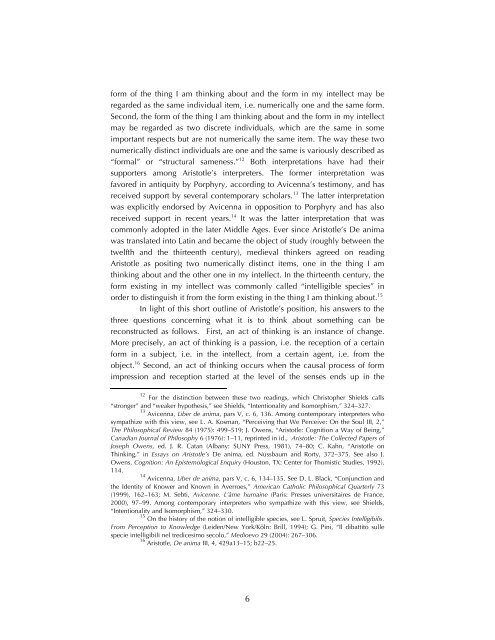Two Models of Thinking - Fordham University Faculty
Two Models of Thinking - Fordham University Faculty
Two Models of Thinking - Fordham University Faculty
Create successful ePaper yourself
Turn your PDF publications into a flip-book with our unique Google optimized e-Paper software.
form <strong>of</strong> the thing I am thinking about and the form in my intellect may beregarded as the same individual item, i.e. numerically one and the same form.Second, the form <strong>of</strong> the thing I am thinking about and the form in my intellectmay be regarded as two discrete individuals, which are the same in someimportant respects but are not numerically the same item. The way these twonumerically distinct individuals are one and the same is variously described as“formal” or “structural sameness.” 12 Both interpretations have had theirsupporters among Aristotle’s interpreters. The former interpretation wasfavored in antiquity by Porphyry, according to Avicenna’s testimony, and hasreceived support by several contemporary scholars. 13 The latter interpretationwas explicitly endorsed by Avicenna in opposition to Porphyry and has alsoreceived support in recent years. 14 It was the latter interpretation that wascommonly adopted in the later Middle Ages. Ever since Aristotle’s De animawas translated into Latin and became the object <strong>of</strong> study (roughly between thetwelfth and the thirteenth century), medieval thinkers agreed on readingAristotle as positing two numerically distinct items, one in the thing I amthinking about and the other one in my intellect. In the thirteenth century, theform existing in my intellect was commonly called “intelligible species” inorder to distinguish it from the form existing in the thing I am thinking about. 15In light <strong>of</strong> this short outline <strong>of</strong> Aristotle’s position, his answers to thethree questions concerning what it is to think about something can bereconstructed as follows. First, an act <strong>of</strong> thinking is an instance <strong>of</strong> change.More precisely, an act <strong>of</strong> thinking is a passion, i.e. the reception <strong>of</strong> a certainform in a subject, i.e. in the intellect, from a certain agent, i.e. from theobject. 16 Second, an act <strong>of</strong> thinking occurs when the causal process <strong>of</strong> formimpression and reception started at the level <strong>of</strong> the senses ends up in the12 For the distinction between these two readings, which Christopher Shields calls“stronger” and “weaker hypothesis,” see Shields, “Intentionality and Isomorphism,” 324–327.13 Avicenna, Liber de anima, pars V, c. 6, 136. Among contemporary interpreters whosympathize with this view, see L. A. Kosman, “Perceiving that We Perceive: On the Soul III, 2,”The Philosophical Review 84 (1975): 499–519; J. Owens, “Aristotle: Cognition a Way <strong>of</strong> Being,”Canadian Journal <strong>of</strong> Philosophy 6 (1976): 1–11, reprinted in id., Aristotle: The Collected Papers <strong>of</strong>Joseph Owens, ed. J. R. Catan (Albany: SUNY Press, 1981), 74–80; C. Kahn, “Aristotle on<strong>Thinking</strong>,” in Essays on Aristotle’s De anima, ed. Nussbaum and Rorty, 372–375. See also J.Owens, Cognition: An Epistemological Enquiry (Houston, TX: Center for Thomistic Studies, 1992),114.14 Avicenna, Liber de anima, pars V, c. 6, 134–135. See D. L. Black, “Conjunction andthe Identity <strong>of</strong> Knower and Known in Averroes,” American Catholic Philosophical Quarterly 73(1999), 162–163; M. Sebti, Avicenne. L’âme humaine (Paris: Presses universitaires de France,2000), 97–99. Among contemporary interpreters who sympathize with this view, see Shields,“Intentionality and Isomorphism,” 324–330.15 On the history <strong>of</strong> the notion <strong>of</strong> intelligible species, see L. Spruit, Species Intelligibilis.From Perception to Knowledge (Leiden/New York/Köln: Brill, 1994); G. Pini, “Il dibattito sullespecie intelligibili nel tredicesimo secolo,” Medioevo 29 (2004): 267–306.16 Aristotle, De anima III, 4, 429a13–15; b22–25.6
















